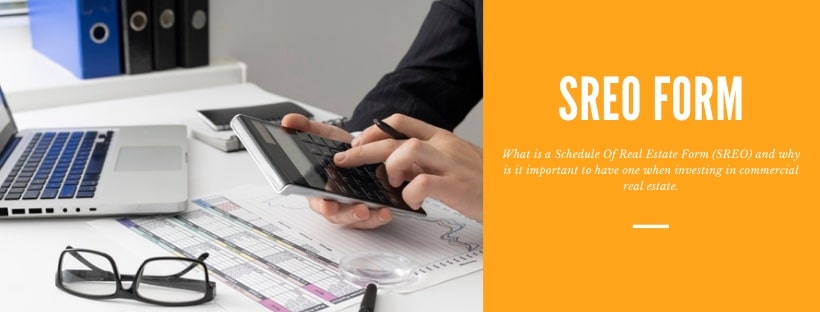How To Build a Schedule Of Real Estate Owned (SREO) Form

Among the many important documents that investors must furnish when applying for a commercial real estate loan is a schedule of real estate owned, or REO schedule.
If you’re applying for a commercial loan soon, here’s an overview of what an SREO form is, why you’ll need one, and how to go about making one.
What is a Schedule of Real Estate Owned?
A schedule of real estate owned form lists all properties that an investor has full or partial ownership of, and it also includes the corresponding debt obligations. The document is a standard piece of the paperwork that lenders ask for when an investor applies for a commercial real estate loan.
Only currently owned properties are included in an REO schedule, and the form is different from a personal financial statement (PFS).
Who Needs an REO Schedule?
The schedule of real estate-owned document is specific to real estate, and only real estate investors need it. While a personal financial statement is widely used for the underwriting of most loan types, individuals who are not investing in real estate (including those who are only buying a primary residence) don’t need an REO schedule.
All investors who do buy real estate on margin need an REO schedule, however. As stated, this is a standard document that lenders and underwriters will need to complete the commercial real estate loan application process.
Answer a few questions and get custom mortgage quotes. We'll match you with offers from our network of 650+ lenders.
How is a Schedule of Real Estate Owned Used?
Once compiled, a schedule of real estate owned may be used by several different parties:
- Lenders: An REO schedule provides lenders with information that’s not included within a credit report. By combining an REO schedule and a credit report together, lenders can more accurately assess the risk level of an investor’s proposed loan. The risk level and quality of a loan must be confirmed before the underwriting process can proceed.
- Underwriters: Underwriters primarily used an REO schedule to calculate the debt-to-income ratio, which is a major factor that they use when calculating the quality of a loan.
- An REO schedule may also be used to further shed light on an investor’s portfolio during a manual underwriting process. For example, an underwriter might view an REO schedule that shows multiple loans being paid off within a year in a favorable light.
- Business Partners: An REO schedule can help instill confidence in potential business partners. Simply having a professionally presentable schedule can help give potential partners confidence in some situations, and the effect is even greater when the REO schedule shows a strong portfolio. This can be an especially important consideration when trying to convince silent partners to join a new deal.
- Real Estate Brokers: An REO schedule can be shown to real estate brokers in order to establish that you’re a serious investor and show them what sorts of properties you’re interested in.
When Should You Create a Schedule of Real Estate Owned?
Investors need a schedule of real estate owned when they go to apply for any commercial real estate loan, and the document should be ready to send to the lender immediately after an initial loan inquiry is made.
In order to ensure that an REO schedule can always be quickly furnished, investors ideally should create the document and keep it updated regardless of whether they’re currently looking for a loan. A best practice is to update the document either monthly or quarterly, so it’s always ready to show lenders, business patterns, and real estate brokers when an opportunity arises.
What Format is Used for an SREO Form?
Most government lending programs have a specifically formatted SREO form if they offer commercial real estate loans, and investors must follow any stipulated form that a program has if they’re applying through the program. For instance, investors who apply for a real estate loan through Fannie Mae, Freddie Mac, the Federal Housing Administration (FHA) or the Department of Housing and Urban Development (HUD) must create their SREO forms according to a specific format.
If not applying through a program that has a specific formula, any SREO format can be used so long as it’s easily readable and contains all necessary information.
How Do You Make a Schedule of Real Estate Owned?
Keep in mind that the purpose of a schedule of real estate owned is to show property owned and corresponding liabilities, and to do this in a clear and concise manner. An SREO form doesn’t need to be long, but just long enough to fit all of the appropriate information.
There are five main sections to an SREO form:
- Personal Details: The personal information that should be on an SREO form includes the investor’s name, address, and contact information (including both phone number(s) and email).
- Property Details: Every property that an investor has an ownership stake in must be listed on an SREO form. For each property, the property type, type, number of units, acquisition date and full address should be listed. Sold properties aren’t listed on an SREO form, although they can be listed on a separate document if desired.
- Ownership Details: The entity that owns each property should be listed, as should the individual investor’s stake in the property.
- Financial Details: The relevant financial details of each property must also be enumerated. These details include the property’s market value, the loan’s amount, the loan’s date, the balance and interest rate on the loan, the monthly payment, and the loan’s maturity date. Market value can be ascertained from the latest appraisal on the property, and the date of the appraisal should also be noted.
- Revenue: To provide some projection on potential revenue, the sale date or cash flow of a property should be noted. For fix-and-flip properties, if/when the property is expected to be sold is needed. For buy-and-hold properties, the occupancy rate and net operating income (NOI) are needed.
Download a Free Schedule of Real Estate Owned Template
Making an REO schedule isn’t difficult if you already have a template to work from. To get started on your own one, download our free SREO template in Excel.


